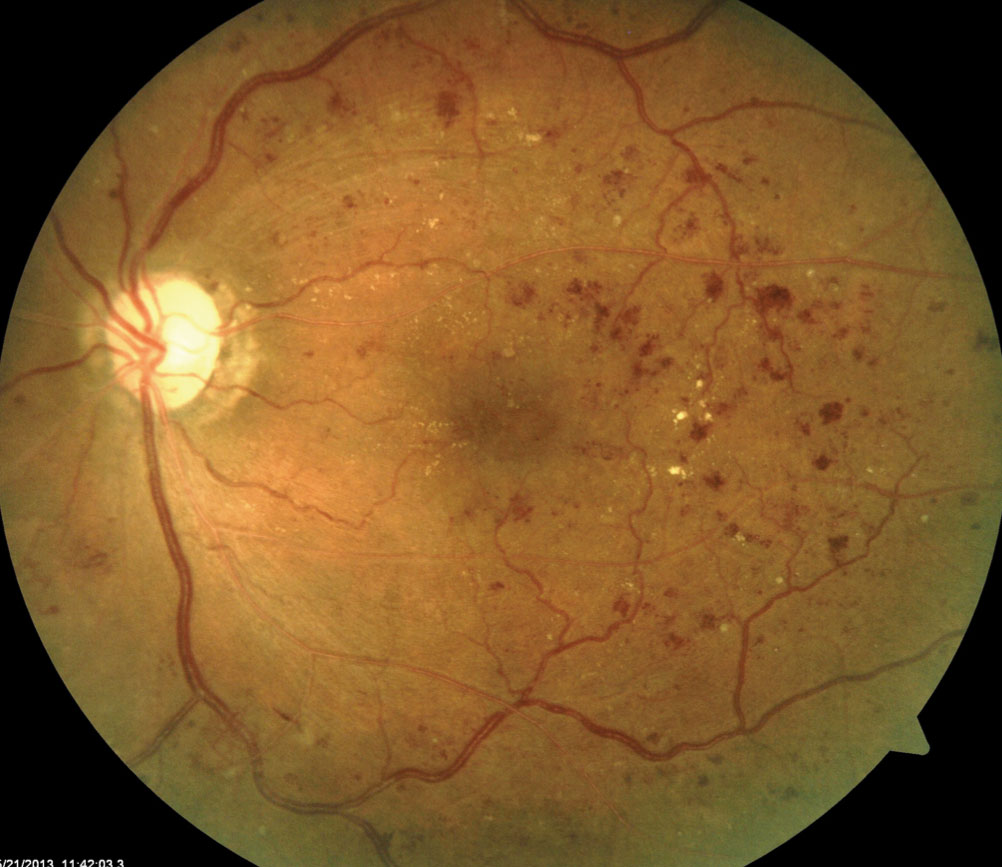 |
|
Neovascularization can be thought of as analogous to earthquakes in mechanism and pattern: catastrophic, unpredictable events. Photo: Julie Torbit, OD, Anna Kathryn Bedwell, OD, Daniel Bollier, OD, and Brad Sutton, OD. Click image to enlarge. |
It’s well known that areas of retinal nonperfusion (NP) can and frequently do give rise to neovascularization (NV) as a corrective mechanism; however, predicting the latter from patterns of the former is quite difficult. A new study offers a possible rationale.
Researchers at the University of Michigan’s Kellogg Eye Center measured distributions of NP surface area using ultra-widefield fluorescein angiography (UWF FA) and found they differed significantly in diabetic retinopathy patients.
Patients were excluded if they had prior panretinal photocoagulation or significant media opacity, including vitreous hemorrhage or significant cataract. The UWF FAs were segmented for NP and NV surface areas. The researchers then mapped the surface areas of all patients onto a histogram and tested whether the results followed a power law distribution (in which change in one variable produces a proportional change in the other) or an exponential distribution (a process in which events occur continuously and independently at a constant average rate).
What they found was a superior fit of NV to fit a power law distribution across 189 images. NP displayed the other, with a superior fit with an exponential distribution when looking over 794 images. Both datasets followed a computational model that fit the principles of what’s known as “self-organized criticality.” This type of observation is also seen with models for how earthquakes and forest fires develop. What this means is that neovascularization may propagate “as a catastrophic event in an unpredictable manner.” They compare the two processes as follows: “Retinal nonperfusion and neovascularization are distinct mechanistic processes, with their own rules. Neovascularization can be thought of as analogous to earthquakes in mechanism and pattern: catastrophic, unpredictable events.”
The researchers outline that for future reference, it is probably not effective to study treatments and their efficacy for NV with normal statistical features like means or variance; rather, modifying the critical exponent, or slope, may offer more meaningful analysis.
The researchers provide an example to demonstrate this effect, providing the instance of a singular, large-scale event that can alter a calculated mean drastically for a dataset that follows a power law, although it would not alter the exponent too much. In line with this, the researchers explain that a higher magnitude exponent seen in a population taking treatment would indicate this group is experiencing less large-scale neovascularization.
They go on to explain the observed differences in statistical distribution attribute to the difficulty of coming up with a predictive model for NV and NP. They continue to specify that factors like duration since diabetes diagnosis, hypertension and BMI can affect the severity of diabetic retinopathy as well as NP and NV, but do not follow the exponential or power law distributions because the patterns don’t rise directly from risk factors such as these.
While neovascularization does not follow the process of persistent progression, non-perfusion does because of its exponential distribution. In this way, loss is proportional to the amount of residual area, where erosion of the perfused retinal areas happens gradually.
Neovascularization, however, seems to follow the same critical event system that is seen in nature in cases of avalanches, forest fires or earthquakes, as well as in market pricing and language. This is due to the system remaining too chaotic for a computer system to predict behavior, even in the presence of granular detail.
The authors of the study believe this suggests that NV and accumulating VEGF levels follow a similar relationship to these natural events. As the authors put, this finding “can allow future work to tap into already developed tools to develop computational models for diabetic retinopathy and fit it to this empirical data” as well as providing use in developing new strategies for treatment.
Young BK, Bommakanti N, Yu G, et al. Retinal neovascularization as self-organized criticality on ultra-widefield fluorescein angiography imaging of diabetic retinopathy. Eye. February 13, 2023. [Epub ahead of print]. |


